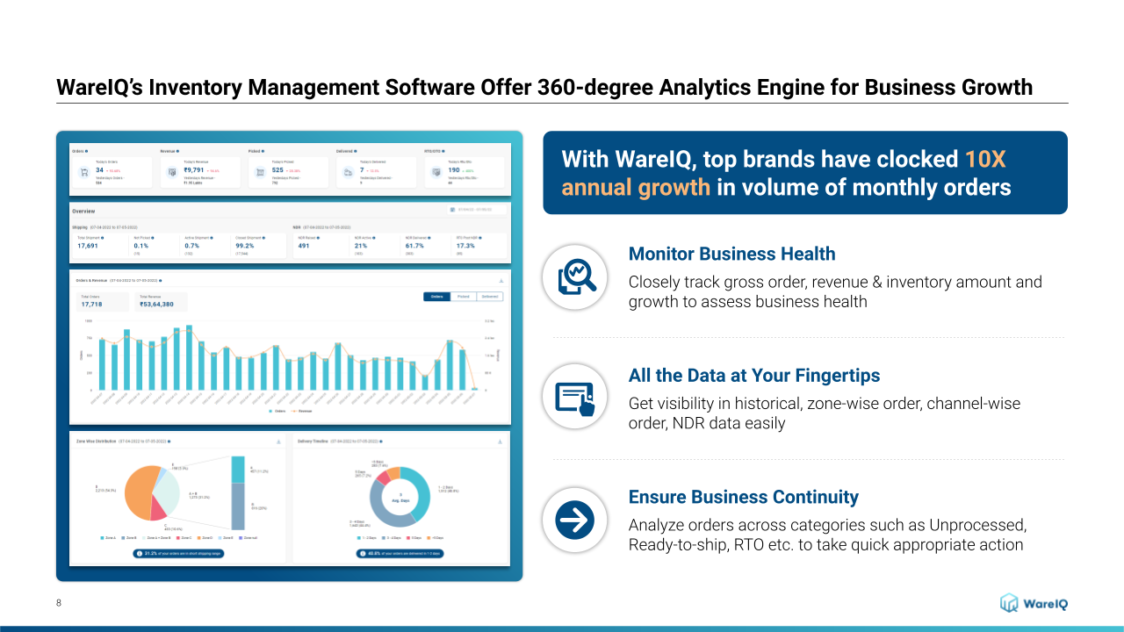eCommerce Catalog Management: A Definitive Guide Including Definition, Challenges, and 10 Best Practices in 2025

Your customers expect consistent product information from you. They appreciate rich images that will help them visualize your products clearly. They want to be able to browse various product categories on your website as efficiently as possible. Without eCommerce catalog management, your product database is bound to deteriorate and hamper your business eventually.
Surveys reveal that 30% of adult online shoppers would consider purchasing from an online retailer they have never shopped with previously if the retailer provided detailed product information.
This means that a website that is simple to navigate, contains current information, and has eye-catching product images will not only draw in repeat customers but will also enhance the likelihood of turning indifferent visitors into devoted ones. In this blog, we will learn about eCommerce catalog management, why it is necessary, common problems faced and the 10 best techniques to make the most of it.
- What is eCommerce Catalog Management?
- Why is eCommerce Catalog Management Necessary?
- 6 Common Problems With Product Catalogs
- 10 Best Techniques for eCommerce Product Catalog Management in 2025.
- Build Brand Confidence With Reliable Product Details
- Tag and Group the Products in Your Digital Catalog
- Implement Process Mapping for Your eCommerce Catalog Management
- Offer Comparable and Alternative Products
- Maintain Your Online Store's Database of Product Catalogs
- Choose a Tool for eCommerce Catalog Management
- Personalize the Product Catalog for Your B2B Online Store
- Use an Inventory Management Software
- Balance Your Physical and Online Catalogs
- Automate Reorder Point Notifications
- Conclusion
- eCommerce Catalog Management: FAQS
What is eCommerce Catalog Management?
eCommerce catalog management refers to the process of ensuring that your product database is structured, up-to-date, and organized across all online sales channels. Because it enables customers to locate what they’re looking for and feel confident making a purchase based on the information supplied, eCommerce catalog management is a crucial part of developing an online brand.
It aids retailers in managing product catalogs for various audiences and helps with inventory tracking across numerous channels for logistical objectives. Although different products require different details and information, product catalogs for online retailers often include information such as color options, pricing, sizes, the country of origin, materials, and more.
WareIQ, an eCommerce fulfillment company, empowers online brands with a superior-tech platform to compete with Amazon like service levels by bringing their average delivery timelines from 5-10 days to 1-2 days.
Why is eCommerce Catalog Management Necessary?
Both B2B and B2C customers are accustomed to doing their product research and purchasing online these days. Therefore, in order to fulfill these client habits, make sure your products are visible and easily available online so that you can maintain your competitiveness. In order to enhance the purchase experience of customers, your firm needs to have a well-managed online product catalog. Concise and thorough eCommerce product catalog management will also help you establish yourself as an authority in your field and win over customers to your online store.
6 Common Problems With Product Catalogs
Problems in eCommerce catalog management can have a negative impact for a variety of reasons which include:
Processing Product Data
Manual entry is inherently laborious and error-prone. Although there are a few choices, such as management systems and automation technologies, eCommerce startup businesses can find it challenging to control operating costs.
Absence of an Integrated Storage System
When a firm grows, using several spreadsheets to keep inventory data causes errors and takes time. A unified data management system is required by vendors and suppliers to remove inconsistencies and search for disparities. Many retailers don’t have the financial resources to invest in these solutions so eCommerce catalog management suffers as a result.
Inefficient SKU Replenishment
Poor SKU management can cause stockouts and other inventory problems that go beyond product cataloging. It is challenging to track which things need to be reordered, where to store certain items based on demand, and ensuring the information presented online is accurate across channels with the ability to track inventory by SKU number.
Difficulty in Integrating Channels
Running a multi-channel marketing strategy is essential for reaching audiences and guiding them through the sales funnel. However, many B2B businesses find it difficult to optimize their offerings on several channels, especially if they don’t have a competent WMS to assist.
Increase in Time Consumption
You may find it challenging and time-consuming to refine and repurpose ERP datasheets for eCommerce product catalog management. Additionally, investing money in data sheets does not always result in high-quality customer-facing content for ongoing updates.
Lack of Planning for Multiple Audiences
Some eCommerce businesses have multiple catalogs for different audiences such as one for B2C orders and another for B2B. A common mistake is not considering the audience type of each catalog. As a result, the information across catalogs is too similar. This can cause issues, especially if you want to display bulk pricing only for B2B customers. Ensuring that you display the right information for different types of catalogs based on the audience is critical.
Solution: Always Think of the Customer
The best way to achieve efficient eCommerce catalog management and streamline different product catalogs based on different audiences is to consider all audiences when curating a catalog and set it up that way in your eCommerce platform. By utilizing inventory technology to automatically display the appropriate details and information for each audience, it is possible to save manual labour and increase accuracy and consistency.
10 Best Techniques for eCommerce Product Catalog Management in 2025.
We’ve compiled the following 10 best practices for managing your eCommerce product catalog to assist you in overcoming various obstacles, which are listed below:
Build Brand Confidence With Reliable Product Details
Make sure your customers feel at ease using your eCommerce site while they shop when implementing eCommerce catalog management. Visitors to your online store should feel confident doing business with you since this will increase their likelihood of making a purchase. You must provide complete and accurate information in your product catalog if you want to accomplish this goal.
To create high-quality product content, you can start with the three factors listed below:
- Incorporate Thorough Details in Your Product Catalog: You should give your buyers all the information they require to quickly evaluate your offerings. Technical characteristics, visuals, inventory data, measurement units, and product usage combinations should be included. This material must be understandable and simple to navigate.
- Verify That All of Your Information is Current: Assisting customers in making informed judgments will improve their purchasing experience. Consider both your static data, such as product specifications and your dynamic inventory data. If necessary, designate someone to be in charge of each adjustment. A different option is to attempt to link your web store inventory to your ERP inventory records so that your web store inventory levels are automatically updated.
- Use Top-Notch Images to Illustrate Your Items: Visitors to your online store will be drawn in and engaged as a result of high-quality images. Utilize several media forms to take it a step further.
Tag and Group the Products in Your Digital Catalog
By giving your customers the opportunity to filter, enhance and sort the product information on your website store, you can make it easier for them to explore your digital product catalogs. All of your products should be consistently tagged and categorized to have successful eCommerce catalog management.
But remember to approach this from your customer’s point of view. Consider how people may search your website and how they might browse for information. Make sure you don’t restrict crediting your products to size and color alone.
Make sure that all product tags are uniform. For instance, do not alternate between labelling things with “medium” and “M”. Instead, solely use “medium” to denote a product size. Make sure that all measurement units are identical. Use either inches or centimetres, and not both, when describing your goods.
Implement Process Mapping for Your eCommerce Catalog Management
eCommerce product catalog management is a complicated procedure, as was already indicated because of the involvement of numerous stakeholders. Making a process map for your catalog management can help you solve this difficulty. The locations of your internal and external stakeholders along this process can then be determined.
You can gain a comprehensive grasp of the following through this mapping process:
- What steps in the catalog management process are impacted by stakeholders?
- Who is impacted by the modifications to your catalog?
- When do people experience the effects of the process?
The mapping method enables you to rapidly identify the precise stakeholders to contact when your eCommerce product catalog needs to be updated.
Let’s take the example of a wholesaler who wishes to add a few products to their online wholesale ecommerce store. You would be better able to comprehend the steps you need to take and in what order if you had a clear map of your catalog management process. Then you’ll be aware that you first need to gather the new product information from the suppliers, determine whether your courier can package the new products using the available resources, commission a product photo shoot with your agency, and ask your internal content team to write the product description, consult with your logistics department to obtain the documentation for new SKUs, etc.
Offer Comparable and Alternative Products
At a physical store, when customers want to check out, they go to the register. Products that may have been forgotten or missed are visible in the checkout area before they take out their credit card to finish the transaction. The same principles apply in an eCommerce setting. If customers can’t find the specific thing they’re looking for, they should be given options or encouraged to browse similar products. To raise the average order value, don’t be afraid to cross-sell and upsell with related and alternative products.
Maintain Your Online Store’s Database of Product Catalogs
Maintaining a database is an essential component of improving eCommerce catalog management because it is a form of information management. The following advice can assist you in maintaining a tidy product catalog database:
- Keep Your Product Catalog’s Source of Truth Consistent: This entails preserving your data in just one database and avoiding its replication in any other system. This is not only more effective but will also eliminate any mistakes.
- Define the Permission Flows and Roles for Database Modification: Stakeholders will be aware of their precise roles and responsibilities when the product catalog database is changed. Authorization flows also assist you in preserving and protecting the integrity of your data and avoiding data duplication.
- Examine the Viability of Increasing Your Database if You Plan to Grow Your Product Catalog: Consider whether any future product catalog data can be collected, organized, and handled using your current data structure. In the event that it isn’t, you should first consider reorganizing your internal data structure to make sure it is scalable.
Choose a Tool for eCommerce Catalog Management
You can manage your online store’s product catalog with the help of a variety of solutions available on the market. Your online store’s eCommerce catalog management can be controlled by:
- an independent online store platform
- a spreadsheet application (e.g. Microsoft Excel)
- a system for product information (PIM)
- a website for online shopping that connects to your ERP
You should take into account your current tech stack, business size, the complexity of your product catalog, availability of your personnel resources, and whether you have plans to grow to multiple online stores in the future when selecting an eCommerce product catalog management application.
Try to maintain a single source of truth no matter which approaches you pick, as noted above, to prevent duplicating product data and running the risk of errors. For instance, you should avoid duplicating the data into a different eCommerce platform if you are already managing your product catalog with an ERP or PIM system. eCommerce that is connected with an ERP makes this possible.
Personalize the Product Catalog for Your B2B Online Store
If you operate a B2B company, you’ll probably have to deal with an additional layer of complexity because your product pricing may vary depending on the customer or the nature of the purchase. For your B2B web business, catalog personalization should therefore be something you really consider. So, pay particular attention to whether your online store has control over the listed price.
Additionally, confirm that your eCommerce catalog management solution enables customized catalogs if you decide to deliver various contents to various consumer categories. The content presented to your clients will be more pertinent to them if you choose a customized catalog option.
Use an Inventory Management Software
Regular inventory checks make sure that the items you list as being accessible online correspond to the actual stock on hand. To prevent backorders or selling an item that won’t be restocked, you should update your product page if a product is out of stock.
Inefficiencies like stocking too many slow-moving items and inventory shrinkage (when real inventory levels don’t match accounting records) can be discovered with the aid of inventory audits.
Balance Your Physical and Online Catalogs
Consider how to make the two catalogs work in harmony if you use an offline product catalog in addition to your web catalog. In contrast, your online catalog can act as a comprehensive and current source of product information for in-depth analysis and comparisons while your offline catalog can act as a simple-to-read product summary for thorough comprehension and to help customers make quick decisions.
Automate Reorder Point Notifications
Using comprehensive inventory management software for your eCommerce catalog management requirements can enable you to set reorder points and have them notify you when the stock of a product falls below the level that was set. This will enable automated reorder triggers to the manufacturer in order to be able to replenish that product and avoid further stockouts and customer dissatisfaction.
Conclusion
The secret to boosting sales and managing a value-driven eCommerce platform is inspiring product data through eCommerce catalog management. People interact with product catalogs to raise awareness and make decisions about purchases. A seamless information flow draws customers back to your store. To organize information and choose appropriate product categories, managing your eCommerce product catalog is essential. If you need assistance with eCommerce product catalog management and any other eCommerce requirement, you can consider partnering with WareIQ, to enhance your digital library and strengthen your competitive edge.

While assisting you in expanding your eCommerce endeavours, WareIQ guarantee no hassles and top-notch product data management. We provide facilities such as a nationwide network of fulfillment centers, a custom WMS that provides facilities such as automated replenishment triggers, the ability to track inventory levels across multiple fulfillment centers and get real-time updates, and integration with more than 12 of the biggest eCommerce marketplaces and much more.







